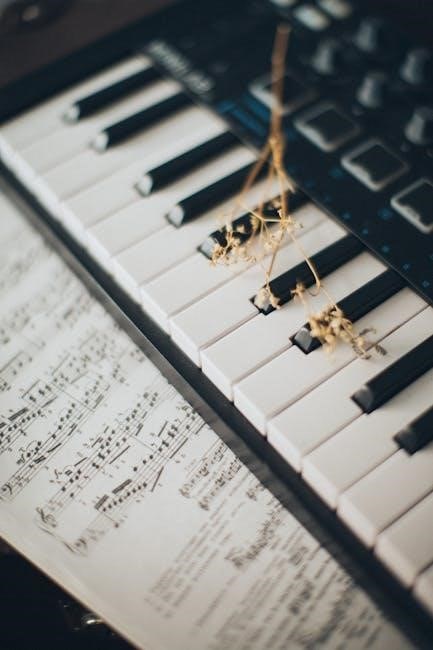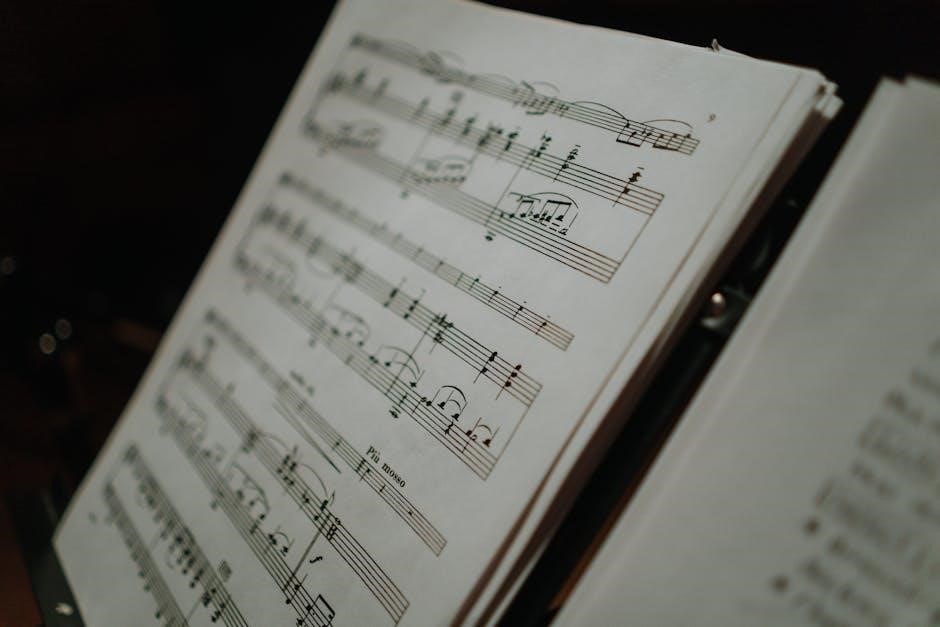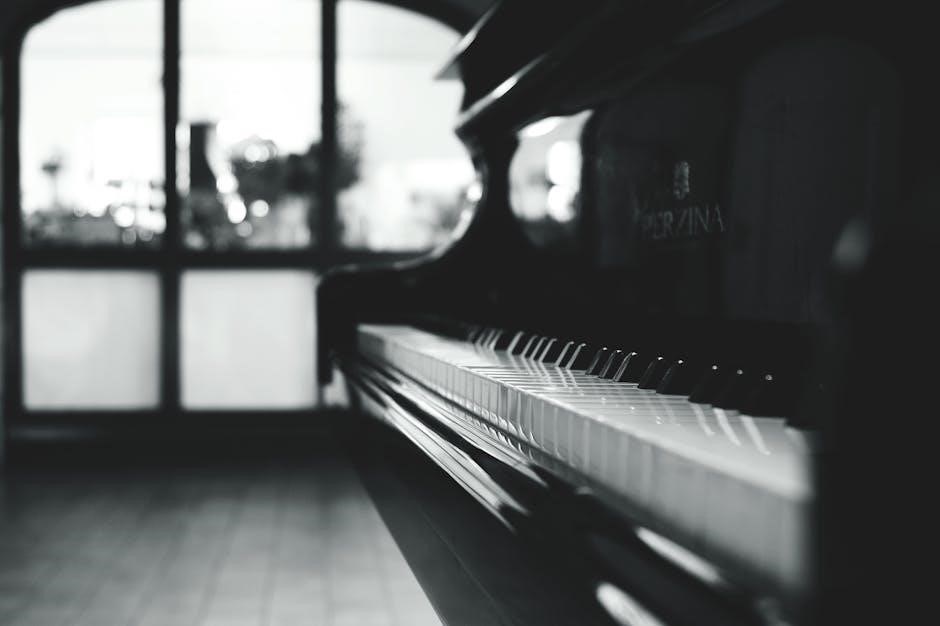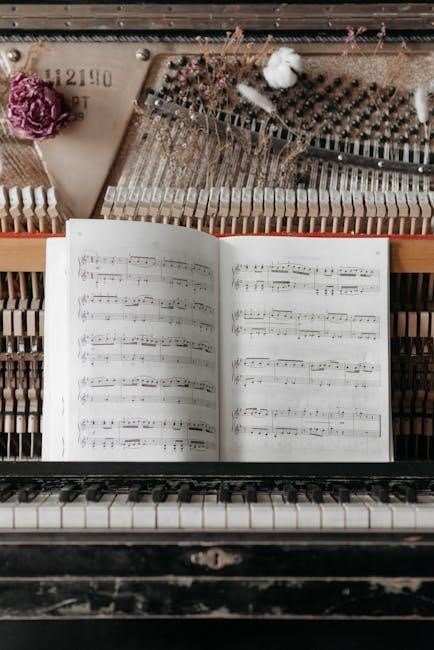“What Was I Made For?” is a captivating ballad by Billie Eilish from the Barbie soundtrack. The song, released on July 13, 2023, features emotional lyrics exploring themes of identity and purpose. Its haunting melody and poignant delivery have resonated with listeners worldwide, making it a standout track from the album. The piano arrangement of this song is highly sought after, with sheet music available in various formats, including PDF and MIDI, catering to pianists of all skill levels.
1.1 Title and Artist Overview
What Was I Made For? is a song by American singer-songwriter Billie Eilish, released on July 13, 2023, as part of the soundtrack for the film Barbie. The track, co-written with her brother Finneas O’Connell, is a piano-led ballad that explores themes of identity and existential questioning. Eilish’s distinctive vocal style and emotional delivery bring depth to the song, which has garnered widespread acclaim and numerous awards, including the Academy Award for Best Original Song. This piece highlights Eilish’s versatility and her ability to craft meaningful, resonant music for film and beyond.
1.2 Song Context and Significance
What Was I Made For? is a poignant ballad featured in the soundtrack of the 2023 film Barbie, directed by Greta Gerwig. The song, released on July 13, 2023, captures themes of self-discovery and existential reflection, resonating deeply with listeners. Its emotional depth and haunting melody have earned it widespread critical acclaim, including major awards such as the Academy Award for Best Original Song. The track’s significance lies in its ability to evoke vulnerability and introspection, making it a standout piece in both the film and Billie Eilish’s discography.

Background of the Song
What Was I Made For? was released on July 13, 2023, as part of the Barbie soundtrack. It was written by Billie Eilish and Finneas O’Connell.
2.1 Composition and Creation
What Was I Made For? is a piano-led ballad written by Billie Eilish and Finneas O’Connell for the Barbie soundtrack. The song features a soft, melancholic melody with introspective lyrics, exploring themes of identity and purpose. Its composition is minimalistic, relying heavily on piano accompaniment to evoke emotional depth. The track was released on July 13, 2023, and quickly gained attention for its raw, heartfelt delivery. The piano arrangement is central to the song’s emotional impact, making it a popular choice for pianists seeking sheet music.
2.2 Artists and Collaborators
What Was I Made For? was written and produced by Billie Eilish and her brother Finneas O’Connell. The song features Billie Eilish on vocals and piano, with Finneas handling production. The track is part of the Barbie: The Album soundtrack, curated for Greta Gerwig’s film. Collaborators include arrangers like Cody Walton, who created a solo piano arrangement. The sheet music has been widely shared across platforms, making it accessible to pianists worldwide. This collaboration highlights the song’s emotional depth and artistic vision.
2.3 Release and Popularity
What Was I Made For? was released on July 13, 2023, as part of the Barbie: The Album soundtrack. The song quickly gained traction, debuting at number 34 on the Billboard Hot 100 and later peaking at number 14. Its emotional resonance and Billie Eilish’s haunting vocals contributed to its widespread acclaim. The track won several awards, including the Oscar for Best Original Song, further boosting its popularity. The piano sheet music became highly sought after, with downloads surging as fans and pianists embraced the song’s simplicity and depth. Its success highlights its enduring appeal and artistic impact.

Musical Structure and Elements
What Was I Made For? is a piano-led ballad in C Major, featuring emotional lyrics and a simple yet powerful melody that resonates deeply, as seen in its sheet music arrangements.
3.1 Melody and Harmony
The melody of What Was I Made For? is a haunting, piano-driven composition that underscores the emotional depth of the lyrics. The song is written in C Major, with a simple yet powerful harmonic structure that complements the introspective nature of the track. The melody flows naturally, creating a sense of vulnerability and resonance. The harmony is minimalist, relying on soft, layered chords that enhance the song’s ethereal quality. This arrangement allows the piano to shine, making it a focal point for conveying the song’s emotional weight and thematic complexity. The interplay between melody and harmony creates a cohesive and moving musical experience.
3.2 Lyrics and Their Meaning
The lyrics of What Was I Made For? delve into themes of existential questioning and self-discovery, with Billie Eilish’s signature introspective tone. The song explores feelings of uncertainty and vulnerability, reflecting on identity and purpose. Written by Billie Eilish and Finneas O’Connell, the words convey a sense of longing and searching, resonating deeply with listeners. The emotional weight of the lyrics is amplified by their simplicity and raw honesty, making the song a powerful expression of universal human emotions. The lyrical depth adds layers of meaning, enhancing the song’s haunting beauty and relatability. The track has also been praised for its poetic and evocative storytelling, further solidifying its impact.
3.3 Key and Tempo
What Was I Made For? is composed in the key of C Major, with a slow and introspective tempo that complements the song’s emotional depth. The steady, mournful pace allows for a hauntingly beautiful melody, emphasizing the track’s reflective and poignant nature. This key and tempo combination creates a sense of simplicity and vulnerability, aligning perfectly with the song’s themes of identity and existential questioning. The arrangement is particularly suited for piano, where the tempo and key can be finely controlled to convey the desired emotional impact, making it a popular choice for pianists seeking expressive pieces.

Piano Sheet Music Details
What Was I Made For? piano sheet music is available in PDF and MIDI formats, featuring both solo piano arrangements and versions with vocal & guitar chords. The sheet music typically spans 2 to 6 pages, with a duration of approximately 4 minutes and 31 seconds; It includes intricate melodies, harmonies, and lyrics, offering a range of arrangements to suit different skill levels, from easy piano to more complex interpretations.
4.1 Arrangement for Solo Piano
The solo piano arrangement of What Was I Made For? captures the emotional essence of Billie Eilish’s ballad, featuring intricate melodies and harmonies. Available in PDF and MIDI formats, the arrangement is designed for pianists to perform the song without vocals or additional instruments. The sheet music includes detailed notation, dynamics, and articulation marks, ensuring an expressive and authentic rendition. With arrangements ranging from easy to advanced, pianists of all skill levels can interpret the song’s haunting beauty. This format highlights the piano’s central role in the original composition, making it a powerful solo piece.
4.2 Difficulty Level
The piano arrangement of What Was I Made For? is moderately challenging, requiring intermediate-level skills. The melody’s emotional depth demands precise dynamics and articulation, while chord progressions and tempo variations add complexity. Simplified versions are available for beginners, offering a more accessible introduction to the piece. Advanced pianists can explore nuanced expressions and intricate fingerwork. The arrangement’s versatility allows pianists of varying proficiency to connect with the song’s haunting beauty, making it a rewarding piece to master. Proper finger placement and dexterity are essential for capturing its emotional essence effectively.
4.3 Pages and Duration
The piano sheet music for What Was I Made For? typically spans between 2 to 6 pages, depending on the arrangement. The song’s duration is approximately 4 minutes and 31 seconds, creating a concise yet emotionally impactful performance. Solo piano versions often feature a more streamlined layout, while arrangements with vocals or guitar chords may extend the page count. The length allows for a focused interpretation, capturing the song’s haunting beauty and Billie Eilish’s poignant delivery. This brevity makes it accessible for practice and performance, ensuring a memorable experience for both players and listeners.

Sources for Downloading the PDF
Download What Was I Made For? piano sheet music from platforms like Musicnotes, Piano Nanny, and free communities. Official sources include the Barbie soundtrack website.
5.1 Official Sheet Music Platforms
Official sheet music for What Was I Made For? is available on platforms like Musicnotes and Piano Nanny. These sites offer high-quality, legally licensed PDF downloads, ensuring authenticity and clarity. Users can access the sheet music instantly, with options for printing or digital viewing. Many platforms also provide interactive scores, allowing pianists to explore the piece dynamically. Additionally, the Barbie soundtrack website and other authorized retailers offer direct downloads, supporting both the artist and the creators. These platforms are trusted sources for accurate and professional arrangements.
5.2 Free Resources and Communities
Free sheet music for What Was I Made For? can be found on platforms like MuseScore and Piano Nanny. These sites offer user-generated arrangements, often available for download in PDF or MIDI formats. Online communities, such as Reddit’s r/piano or r/sheetmusic, also share free resources. Additionally, forums like Piano World provide links to free sheet music, fostering a supportive environment for pianists to learn and share. These platforms are great for accessing arrangements without cost, though they may vary in accuracy and quality compared to official versions.
5.4 Paid options
Premium sheet music for What Was I Made For? is available on official platforms like Musicnotes and Sheet Music Plus. These sites offer high-quality, officially licensed arrangements in PDF format, ensuring accuracy and professional formatting. Paid versions often include additional features like interactive scores, transpose options, and lyrics. Platforms like Piano Nanny also provide paid downloads, guaranteeing authenticity and completeness. Purchasing from these sources supports artists and ensures you receive a polished, error-free version of the sheet music, ideal for both personal and professional use. Licensing for public performance is also available through these platforms.

Key Features of the Sheet Music
The sheet music for What Was I Made For? features clear notation, dynamics, and articulation, ensuring expressive performance. Chord progressions are thoughtfully arranged for emotional impact, capturing the song’s essence perfectly.
6.1 Notation and Layout
The sheet music for “What Was I Made For?” by Billie Eilish is meticulously notated, ensuring clarity and ease of reading for pianists. The layout is clean and well-organized, with precise placement of notes, rests, and dynamics. The use of standard musical symbols and clear typography enhances readability, making it accessible for players of all levels. The PDF format preserves the integrity of the arrangement, allowing for easy printing and digital viewing. This attention to detail ensures an accurate representation of the song’s emotional depth and complexity.
6.2 Dynamics and Articulation
The sheet music for “What Was I Made For?” incorporates detailed dynamics and articulation markings, essential for capturing the song’s emotional depth. Soft, delicate passages are marked with pianissimo (pp) and crescendo, guiding pianists through the song’s gradual build-up. Articulations like legato and staccato are clearly indicated, ensuring a nuanced performance. These markings help convey the introspective and haunting qualities of the track, making the sheet music a valuable resource for accurately interpreting Billie Eilish’s vision. The attention to dynamic and articulative detail enhances the song’s expressive potential.
6.3 Chord Progressions
The piano sheet music for “What Was I Made For?” features a chord progression in C Major, creating a melancholic yet resonant foundation. The progression alternates between minor and major chords, evoking a sense of introspection and emotional depth. The use of suspended chords and subtle modulations adds complexity, while the repetitive structure maintains a haunting simplicity. These progressions complement the song’s themes of self-discovery and vulnerability, providing a harmonic framework that supports the vocal melody and enhances the overall mood. The chord voicings are arranged to emphasize clarity and emotional impact, making the piece accessible for pianists of various skill levels.

Playing Tips and Techniques
Emphasize dynamics and tempo control to capture the song’s emotional depth. Focus on expressive phrasing and nuanced articulation to convey vulnerability and introspection effectively.
7.1 Finger Placement and Dexterity
Mastering “What Was I Made For?” requires precise finger placement and dexterity, especially in the right-hand melody. Focus on finger independence to navigate the arpeggios and broken chords smoothly. Practice slow tempos to build control, gradually increasing speed. Pay attention to dynamics, as subtle variations enhance the emotional impact. Use finger stretches for larger intervals and maintain a relaxed hand position to avoid fatigue. Prioritize clarity in every note, ensuring a balanced sound that complements the song’s introspective nature.
7.2 Expressive Elements
Expressive elements are vital in “What Was I Made For?” to convey its emotional depth. Dynamics play a crucial role, with soft passages requiring delicate touch and louder sections demanding intensity. Pay attention to rubato, allowing slight tempo fluctuations to emphasize lyrical phrases. Phrasing should be legato, creating a flowing, vocal-like quality. Articulation varies, blending both staccato and legato to match the song’s mood. Use pedaling strategically to sustain tones and enhance resonance, ensuring the melody’s haunting beauty shines through. Balance and control are key to delivering a heartfelt performance.
7.3 Practice Strategies
Effective practice strategies for “What Was I Made For?” involve breaking the piece into sections and mastering each part gradually. Start with a slower tempo to ensure accuracy, then gradually increase speed. Focus on dynamics, emphasizing soft passages and building intensity in louder sections. Use a metronome to maintain consistent timing, especially during tempo changes. Practice hands separately before combining them to refine intricate melodies. Pay attention to phrasing and rubato to capture the song’s emotional essence. Regular practice, even in short sessions, will help develop muscle memory and expressive control, ensuring a polished performance.
Cultural and Artistic Impact
“What Was I Made For?” significantly impacted the Barbie soundtrack, earning acclaim and awards, including an Oscar and Golden Globe, while resonating deeply with listeners worldwide.
8.1 Role in the Barbie Soundtrack
“What Was I Made For?” is a pivotal track from the Barbie soundtrack, released on July 13, 2023. The song, written by Billie Eilish and Finneas O’Connell, is a poignant ballad that captures themes of identity and purpose. Its emotional depth resonated deeply, making it a standout piece in the album. The track’s piano arrangement, featured prominently in the song, has been widely praised and sought after by pianists. The song’s inclusion in the Barbie soundtrack not only enhanced the film’s narrative but also showcased Eilish’s ability to craft meaningful music for cinematic contexts.
8.2 Reception and Reviews
“What Was I Made For?” received widespread acclaim for its emotional depth and haunting melody. The song won the Oscar for Best Original Song, a Golden Globe, and multiple Grammy nominations, solidifying its impact. Critics praised Billie Eilish’s vocals and the song’s lyrical honesty, while the piano arrangement was highlighted for its simplicity and effectiveness. The track debuted at number 34 on the Billboard Hot 100, peaking at number 14, showcasing its resonance with audiences. Its success underscored Eilish’s ability to craft meaningful, emotionally charged music for both films and personal expression.
8.3 Awards and Nominations
“What Was I Made For?” earned significant recognition, including an Oscar for Best Original Song and a Golden Globe for Best Original Song. It also received five Grammy nominations, showcasing its artistic and emotional impact. The track’s success was further highlighted by its chart performance, peaking at number 14 on the Billboard Hot 100. These accolades underscore the song’s resonance and its contribution to the Barbie soundtrack, solidifying its place in contemporary music history.

Sheet Music Formats and Variations
The sheet music for “What Was I Made For?” is available in solo piano arrangements, instrumental combinations, and simplified versions. Formats include PDF and MIDI, catering to various skill levels and preferences, ensuring accessibility and adaptability for musicians.
9.1 Solo Piano Arrangements
The solo piano arrangements of “What Was I Made For?” are designed to capture the emotional depth of Billie Eilish’s original track. These arrangements are available as digital PDF downloads, offering pianists a clean and professional notation. The sheet music typically includes the song’s melody, harmony, and lyrics, arranged specifically for solo piano performance. This format allows for a intimate rendition of the song, maintaining its haunting beauty while adapting it for individual play. Many versions are simplified to accommodate pianists of different skill levels, ensuring accessibility and enjoyment.
9.2 Instrumental Combinations
The sheet music for “What Was I Made For?” is also available in instrumental combinations, offering versatility for performers. These arrangements often include piano, vocal, and guitar chords, allowing for collaborative performances. Some versions feature additional instrumentation, such as strings or woodwinds, to enhance the song’s emotional depth. These combinations are ideal for those who prefer playing with accompaniment or experimenting with layered sounds. Digital PDF formats make it easy to access and print these arrangements, catering to both individual and group performances while maintaining the song’s original essence and complexity.
9.3 Simplified Versions
Simplified versions of “What Was I Made For?” piano sheet music are available for beginners or those seeking easier arrangements. These versions maintain the song’s emotional core while reducing complexity, focusing on essential melodies and harmonies. They often include fewer intricate details, making them accessible to pianists with limited experience. Many platforms offer “Easy Piano” adaptations, ensuring that the essence of the song remains intact. These simplified sheets are ideal for practice, allowing players to gradually build skill and confidence before tackling more advanced arrangements.

Digital and Print Options
Digital downloads of “What Was I Made For?” piano sheet music are instantly accessible in PDF format, allowing for easy printing. Licensing options permit legal sharing and adaptation, ensuring versatility for both personal and professional use.
10.1 Instant Downloads
The piano sheet music for “What Was I Made For?” is available as an instant digital download in PDF and MIDI formats. Upon purchase, the file is delivered immediately, allowing pianists to access the music without delay. This convenient option ensures that musicians can start practicing or performing the piece right away. The PDF format is compatible with most devices and can be easily printed for personal use. Additionally, some platforms offer MIDI files for those who wish to explore the song’s melody digitally. This instant access feature has made the sheet music highly popular among pianists worldwide.
10.2 Printing Guidance
Printing the “What Was I Made For?” piano sheet music is straightforward. Ensure your printer is set to high-quality settings for clear notation. Use standard A4 or letter-sized paper for optimal formatting. The PDF file is typically designed to fit perfectly on the page, eliminating the need for adjustments. For best results, use bright white paper to maintain legibility. Some platforms provide guidance on margins and scaling to ensure the music prints correctly. Always check the preview before printing to confirm the layout and alignment of the musical notes and lyrics. This ensures a professional and readable final product;
10.3 Licensing and Sharing
Licensing for “What Was I Made For?” piano sheet music varies by platform. Free versions often require attribution to the original author, allowing sharing and remixing for non-commercial use. Paid options may offer broader usage rights, including commercial applications. Sharing is typically permitted for personal or educational purposes, with proper citation. Some platforms restrict sharing to maintain copyright integrity, while others encourage community distribution. Always review the licensing terms to ensure compliance with the creator’s permissions and rights.

Community and Sharing
The piano sheet music for “What Was I Made For?” has fostered a vibrant community, with users sharing arrangements and collaborating on platforms like MuseScore and Piano Nanny.
11.1 User-Generated Content
Users worldwide have created and shared their unique arrangements of “What Was I Made For?” for piano, fostering a vibrant community of creators and enthusiasts. Platforms like MuseScore and Piano Nanny host a variety of user-generated sheet music, offering diverse interpretations of the song. These contributions range from simplified versions for beginners to complex arrangements that showcase artistic flair. The sharing of these adaptations not only promotes accessibility but also encourages collaboration and innovation among musicians. This collective creativity highlights the song’s universal appeal and its ability to inspire personal expression.
11.2 Collaborative Platforms
Collaborative platforms have become hubs for pianists and music enthusiasts to share and refine “What Was I Made For?” arrangements. Websites like MuseScore and Piano Nanny enable users to upload, download, and collaborate on sheet music in real-time. These platforms foster creativity by allowing version control and joint editing, ensuring that the best ideas shine. They also provide spaces for feedback and iteration, making them invaluable for refining performances and interpretations of the song. Such collaborations highlight the power of community-driven music creation and sharing in the digital age.
11.3 Reviews and Feedback
Reviews of “What Was I Made For?” piano arrangements highlight the emotional depth and resonance of the song. Many pianists praise the sheet music for its clarity and accuracy, while listeners appreciate the haunting melody. Feedback often mentions how the arrangement captures the essence of Billie Eilish’s vocals, translating beautifully to piano. The song’s success is evident in its critical acclaim, including major awards like the Oscar and Golden Globe for Best Original Song. Users on platforms like MuseScore and Piano Nanny frequently share their interpretations, showcasing the track’s versatility and timeless appeal. This collaborative exchange enriches the musical experience for both performers and audiences alike.
“What Was I Made For?” by Billie Eilish is a masterpiece that transcends musical boundaries, resonating deeply with listeners and pianists alike. Its emotional depth and haunting melody have made it a standout piece in the Barbie soundtrack. The availability of high-quality piano sheet music in PDF and MIDI formats has allowed pianists of all levels to engage with the song creatively. With its critical acclaim and widespread popularity, this track continues to inspire, making it a timeless addition to any pianist’s repertoire. Its impact is a testament to the power of music to evoke emotion and connection.
